The Red and the Slack
Jennifer Gilmore’s latest novel grapples with the legacy of Jewish radicalism in the late 20th century




Is it too soon to say that the Brandeis novel is having a moment? It is, at least, an intriguing coincidence that two novels published recently are set at Brandeis University in the 1970s and that both feature a comically ineffectual campus protest. In 36 Arguments for the Existence of God, which came out at the beginning of this year, Rebecca Newberger Goldstein thinly disguised the school as Frankfurter University (Brandeis was the first Jewish Supreme Court Justice, Frankfurter the second) and joked about a student uprising against the introduction of fraternities and sororities. Taking a cue from some earlier Jews who didn’t like the Greek system, Goldstein’s protesters call themselves Maccabees.
Politics and protest are far more central to Something Red, the new novel by Jennifer Gilmore, but she too conceives of a Brandeis uprising as something inherently comical. Early in the book, Benji Goldstein, the athlete son of a liberal D.C. clan, stumbles into a ragged rally on the Waltham campus—actually a counterprotest, in which a few students are opposing a larger student movement to ban nonkosher food from the dining halls. Here Benji meets Rachel Feinglass—“olive-skinned, black-haired, short, big-breasted”—who is sufficiently political to fight for the right of Jewish students to eat pork, even though she herself is a vegetarian. “This is about truth, about what this university is supposed to stand for. This is a participatory democracy,” she harangues, and Benji is more than convinced. On the spot, he falls in love with Rachel, with Brandeis, and with the idea of radical protest, all of which are mixed up in his inarticulate but heartfelt declaration, “I fucking love college.”
Of course, student demonstrations at Brandeis were not always so silly. In the 1960s, Benji learns in his class “American Protest!” (the exclamation point is a nice touch), the school produced radicals like Abbie Hoffman and Angela Davis. But Gilmore’s novel is set in 1979—the year of the Iran hostage crisis and President Carter’s grain embargo on the Soviet Union—and all that remains of the ’60s spirit is the Grateful Dead and dropping acid. “Each and every day Benji sat in a lecture, he wished he’d been born a decade and a half previously,” Gilmore writes, and this sense of belatedness is the real theme of Something Red. Can Jews in the 1970s—and by implication, in our own time—really lay claim to the legacy of Jewish radicalism that dates back to the early 20th century?
For the Goldstein family, this is not just an abstract question. Sigmund, Benji’s grandfather, came out of the radical forcing-house that was City College in the 1930s and spent his youth as a socialist organizer. Even now he refuses to move away from the Lower East Side, out of a sense of solidarity with his poor neighbors, who are no longer Jewish but Asian and Latino. But Sigmund’s politics, Gilmore shows, long ago seemed obsolete to his son Dennis, who was born in the late 1930s, making him just too old to participate fully in the Sixties counterculture. Dennis, a mid-level official in Department of Agriculture, went to marches on the Mall—for civil rights, against Vietnam—but he always took his wife, Sharon, and his children, Benji and Vanessa, with him. Living in suburban Washington, working for the government, he was part of the system his father tried to overthrow:
Didn’t he think of his father watching him as he sat at his desk, waiting for his administrative instructions? Brief this one, brief that one. Toe the party line. … It was confusing to him: working from within the government was both the most benevolently liberal thing he could do, the most socialist really; had the last gasp of the sixties not been evidence of this? So why now did government work feel sometimes to Dennis like the most conservative anti-individual, anti-independent thinking move he could have made? Where did he stand?
If there is a wrong note in this soliloquy, it is the word “socialist.” No child of a radical like Sigmund, no one who lived through the 1960s, would think of working in the Department of Agriculture as a contribution to socialism. For someone like Dennis, that word would have much more radical and revolutionary implications than it apparently does for Gilmore, who treats it as simply a superlative of liberal. This kind of uncertainty frequently plagues Gilmore’s treatment of Jewish-American politics—above all when it comes to Sigmund, his Russian-born wife Tatiana, and their lives in the 1930s. Trying to parse Sigmund’s biography, based on the references he makes, is quite impossible, because the novel does not have a firm grasp on that complex period. Thus we hear that Sigmund was a Trotskyist, a Communist Party member, and a supporter of the Socialist presidential candidate Norman Thomas, all apparently at the same time—though these were three distinct political orientations that would have been quite incompatible in the ideologically fractured 1930s.
In this way, ironically, Something Red enacts the very phenomenon it means to describe: contemporary Jews’ loss of connection with their radical past. The closer Gilmore comes to her own generation, by contrast—she graduated from Brandeis in 1992, about a decade after Benji was there—the more authentic and compelling her observations become. For Benji and his younger sister Vanessa—who is still stuck at home, full of teenage rebellion and anguish—music meets all the needs that politics did for Sigmund. When Benji gets high at a Dead concert, he experiences his own kind of classless society: “Benji was instantly drawn to the sense of community and understanding, this insular world that shirked all preconceived notions of what happened outside it. From the moment he stepped into the Coliseum parking lot before the music started: happiness unadulterated. Pure utopia.”
Utopia, for the 1930s radicals, meant social transformation, which required organizing, indoctrination, and violent revolution; for Benji in the 1970s, it means personal transformation, totally subjective and hedonistic. For Vanessa, who is drawn to the Straight Edge punk lifestyle—no drugs or alcohol, just loud ugly music in packed clubs—community is apolitical in a different way: “Shirtless boys slammed into one another, bodies so thin and lanky she could see their blue hearts beating through their chests. There was no way to be separate. This was real protest music, Vanessa thought. … It did something, and it did it close to your face.” For Benji and Vanessa’s mother, Sharon, an equally ersatz community is found in a self-actualization cult called LEAP, where she goes in search of the inspiration that politics and religion no longer provide.
Gilmore writes with affection and authority about the early D.C. punk scene—she knows Madam’s Organ and the Slickee Boys better than she knows the International Ladies’ Garment Workers Union and the Rosenberg case. And Vanessa, with her wholly personal struggles—against her mother, her peers, her own body—emerges as the best-drawn character in Something Red. Partly this is because, when writing about Vanessa, Gilmore is able to lose herself in the intimate evocations of suburban childhood that are the novel’s best passages. Compared to these, the plot involving Dennis Goldstein’s business trips to Moscow, and the sudden revelation of a spy in the family, feel awkwardly contrived. As Gilmore shows, political passion comes and goes in historical cycles, and Something Red is clearly the product of a time when the private has a greater hold on our imagination than the public.
Adam Kirsch is a poet and literary critic, whose books include The People and the Books: 18 Classics of Jewish Literature.
Adam Kirsch is a poet and literary critic, whose books include The People and the Books: 18 Classics of Jewish Literature.